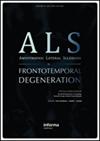用Kinect传感器纵向评价渐冻症患者上肢可达工作空间
IF 2.8
4区 医学
Q2 CLINICAL NEUROLOGY
Amyotrophic Lateral Sclerosis and Frontotemporal Degeneration
Pub Date : 2017-01-02
DOI:10.1080/21678421.2016.1241278
引用次数: 16
摘要
我们的目的是评估在一组肌萎缩性侧索硬化症(ALS)患者中,微软Kinect测量的上肢可达工作空间相对表面积(RSA)与修订后的肌萎缩性侧索硬化症功能评定量表(ALSFRS-R)、ALSFRS-R上肢亚量表和用力肺活量(FVC)的纵向变化。10名被诊断为ALS的患者(年龄52-76岁,入组时ALSFRS-R: 8-41)使用单一3D深度传感器微软Kinect进行测试,在一年的五次访问中测量可到达的工作空间RSA。采用线性混合模型评估RSA、ALSFRS-R、ALSFRS-R上肢子量表和FVC的变化。结果表明,上外侧象限的RSA在一年内显著下降了约19% (p <0.01),而其他象限和总RSA在此期间无显著变化。同时,ALSFRS-R上肢亚量表加重了25% (p <0.01)。综上所述,上肢可达工作空间RSA作为一种新的ALS结局测量指标,能够客观量化ALS患者上肢能力随时间的下降,比其他常见结局测量指标更具粒度。RSA可以作为评估上肢靶向治疗的临床终点。本文章由计算机程序翻译,如有差异,请以英文原文为准。
Longitudinal evaluation of upper extremity reachable workspace in ALS by Kinect sensor
Abstract Our objective was to evaluate longitudinal changes in Microsoft Kinect measured upper extremity reachable workspace relative surface area (RSA) versus the revised Amyotrophic Lateral Sclerosis Functional Rating Scale (ALSFRS-R), ALSFRS-R upper extremity sub-scale and Forced Vital Capacity (FVC) in a cohort of patients diagnosed with amyotrophic lateral sclerosis (ALS). Ten patients diagnosed with ALS (ages 52–76 years, ALSFRS-R: 8–41 at entry) were tested using single 3D depth sensor, Microsoft Kinect, to measure reachable workspace RSA across five visits spanning one year. Changes in RSA, ALSFRS-R, ALSFRS-R upper extremity sub-scale, and FVC were assessed using a linear mixed model. Results showed that upper lateral quadrant RSA declined significantly in one year by approximately 19% (p <0.01) while all other quadrants and total RSA did not change significantly in this time-period. Simultaneously, ALSFRS-R upper extremity sub-scale worsened significantly by 25% (p <0.01). In conclusion, upper extremity reachable workspace RSA as a novel ALS outcome measure is capable of objectively quantifying declines in upper extremity ability over time in patients with ALS with more granularity than other common outcome measures. RSA may serve as a clinical endpoint for the evaluation of upper extremity targeted therapeutics.
求助全文
通过发布文献求助,成功后即可免费获取论文全文。
去求助
来源期刊

Amyotrophic Lateral Sclerosis and Frontotemporal Degeneration
CLINICAL NEUROLOGY-
CiteScore
5.40
自引率
10.70%
发文量
64
期刊介绍:
Amyotrophic Lateral Sclerosis and Frontotemporal Degeneration is an exciting new initiative. It represents a timely expansion of the journal Amyotrophic Lateral Sclerosis in response to the clinical, imaging pathological and genetic overlap between ALS and frontotemporal dementia. The expanded journal provides outstanding coverage of research in a wide range of issues related to motor neuron diseases, especially ALS (Lou Gehrig’s disease) and cognitive decline associated with frontotemporal degeneration. The journal also covers related disorders of the neuroaxis when relevant to these core conditions.
 求助内容:
求助内容: 应助结果提醒方式:
应助结果提醒方式:


